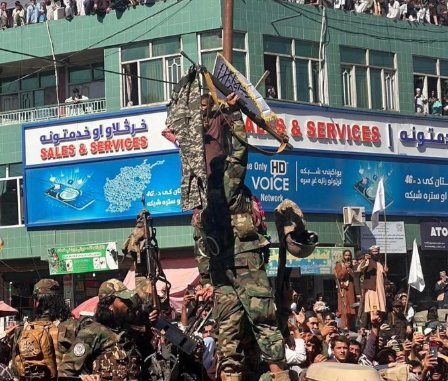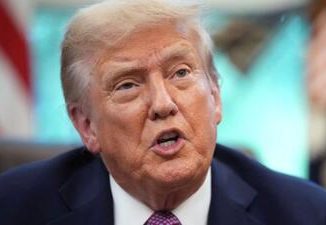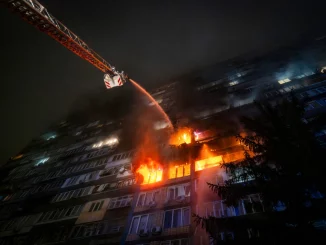
‘Empty trousers’, recovered from abandoned military posts of Pakistani army near Durand Line displayed in eastern Nangrahar province, Afghanistan.
Published October 16, 2025
Smoke Along the Durand: Symbolic Victory and Border Fire
On the night of October 12–13, 2025, new flames flared along the long-contested Afghanistan-Pakistan frontier. The Taliban announced that its forces had killed 58 Pakistani soldiers in retaliatory operations—claiming also that they captured 25 border posts and wounded many more. In a dramatic display, they publicly exhibited Pakistani soldiers’ pants and weapons in a public square, symbolizing what they called a “victory” over Islamabad’s forces.
Pakistan, however, contests the Taliban figures: its military admitted to 23 dead on its side, and claims to have neutralized over 200 Taliban fighters in counter-operations. Islamabad described the border strikes by Kabul as “unprovoked” and asserted it destroyed several Taliban posts.
Tensions escalated further when Pakistan retaliated with airstrikes over Kabul and eastern Afghan provinces, which local reports say killed some civilians. In response, Afghanistan reportedly sent tanks to its border.
A 48-hour ceasefire was declared midweek following mounting public pressure and regional diplomatic efforts, though sporadic firefights have persisted.
Historical Context & Stakes at the Frontier
The Durand Line: A Fractured Border
The Durand Line, drawn in 1893 by the British colonial administration, partitions the Pashtun tribal lands across what is today Afghanistan and Pakistan. Kabul never formally recognized it as an international border, and many in Afghanistan regard it as a colonial imposition.
This ambiguity has long fueled cross-border militant movement, local grievances, and military flashpoints. Pakistan accuses the Taliban regime of harboring the Tehrik-e-Taliban Pakistan (TTP), a militant group that stages attacks inside Pakistan. The Taliban deny they provide safe haven.
Proxy Conflict and Peril
Beyond border skirmishes, the fight is also about influence, prestige, and control of militant networks. Pakistan sees the Taliban as complicit in allowing TTP bases; the Taliban view Pakistani strikes and alleged airspace violations as interference and assertion of dominance.
Local Pashtun populations on both sides may feel caught in the middle—or drawn into the fight. Some Afghan civilian voices, especially in Kandahar, voiced support for the Taliban’s retaliation, declaring readiness to join the mujahideen.
Meanwhile, border towns and trade routes suffer. Pakistan closed crucial crossings like Torkham and Chaman, stranding goods and people.
Challenges of Verification & Propaganda
In battles like these, truth is often the first casualty. Both sides issue contradictory casualty claims and control over territory. Independent verification is extremely difficult due to contested access, media restrictions, and war reporting constraints in border regions.
The display of soldiers’ pants and weapons is clearly as much symbolic propaganda as it is military boasting—a tactile image meant to demoralize the enemy, rally supporters, and frame the narrative of dominance.
 Public / Political Reactions
Public / Political Reactions
Political Reactions in Pakistan
-
Prime Minister Shehbaz Sharif
-
Condemned what he termed “provocations” by Afghan forces after claims of Pakistani casualties.
-
Promised a “strong and effective response,” underlining that Pakistan will defend every inch of its territory.
-
Praised the armed forces for their “robust and professional response.”
-
-
Military (ISPR, Pakistani Armed Forces)
-
Claimed 23 Pakistani soldiers were killed, and over 200 Taliban / affiliated “terrorists” were neutralized in response.
-
Framed their actions as defensive: a response to unprovoked attacks from Afghan Taliban and groups like the TTP or what they describe under “Fitna-al-Khawarij.”
-
Also emphasized protection of civilians, saying that operations target terrorist infrastructure, not the Afghan civilian population.
-
-
Other Political Figures & Parties in Pakistan
-
Broad cross-party support for the armed forces. President Asif Ali Zardari, provincial leaders, chief ministers, provincial governors all voiced support.
-
Sindh Governor Kamran Tessori warned of more severe responses if provocations continue.
-
Bilawal Bhutto-Zardari urged the Taliban government in Kabul to act with restraint and to do more against militant groups, while also supporting Pakistan’s right to defend itself.
-
-
Government of Afghanistan (Taliban Authorities)
-
Claimed they had killed 58 Pakistani soldiers in retaliatory border operations, captured a number of Pakistani posts, and destroyed weapons.
-
Also, Taliban officials warned that any future violations of Afghan territory would be met with strong response.
-
Public Reactions & Diplomacy / International Responses
-
Domestic Public Opinion (Pakistan)
-
Political parties and leaders stress unity behind the armed forces. The issue is being framed as a matter of national sovereignty and territorial integrity.
-
Media coverage and political rhetoric indicate high pressure on the government and military to act decisively. The narrative of “no compromise on defence” is prominent.
-
-
International / Regional Reactions
-
Calls for restraint: regional players and possibly diplomatic mediators (e.g. Saudi Arabia, Qatar) have been involved in pushing for de-escalation. (Temporary ceasefire was agreed.)
-
India spoke out in support of Afghanistan’s sovereignty, criticizing Pakistan.
-
-
Diplomatic and Strategic Considerations
-
Pakistani leaders are pressing the Afghan Taliban to take “concrete and verifiable” action against militant groups that allegedly operate from Afghan soil.
-
The timing of Taliban foreign minister Amir Khan Muttaqi’s visit to India has been cited by Pakistani officials as suspicious or deliberate—seen as part of a diplomatic dimension to the tension.
-
 Resulting Effects
Resulting Effects
1. Escalating Military Tensions
The recent Taliban–Pakistan skirmishes mark one of the deadliest post-2021 border incidents between the two.
-
The Taliban’s claim of killing 58 Pakistani soldiers — and Pakistan’s counterclaim of killing over 200 Taliban fighters — have further deepened mistrust.
-
Pakistan has since reinforced its Khyber Pakhtunkhwa and Balochistan border zones with tanks and artillery, signaling readiness for sustained conflict.
-
The Taliban, in turn, have deployed additional border units and fortified captured posts along the Durand Line, using seized Pakistani weapons as propaganda tools.
2. Collapse of Border Trade and Civilian Movement
-
Torkham and Chaman crossings, key arteries for trade and humanitarian movement, were temporarily shut down. This halted shipments of essential goods and medical supplies.
-
Truck drivers, traders, and civilians are stranded on both sides, with some Afghan families reportedly attempting to cross into Pakistan for safety but being denied entry.
-
The disruption threatens regional supply chains, especially Afghanistan’s imports of wheat, fuel, and medicine, which depend heavily on Pakistan.
3. Surge in Anti-Pakistan Sentiment within Afghanistan
-
The Taliban’s public display of Pakistani soldiers’ uniforms — and the narrative of “victory” — has sparked nationalist fervor.
-
Social media in Afghanistan saw hashtags celebrating the “defense of Afghan soil,” framing the conflict as a restoration of sovereignty over a colonial-era line.
-
This sentiment further reduces chances of future intelligence or counterterror cooperation between Islamabad and Kabul.
4. Heightened Regional Polarization
-
India’s diplomatic support for Afghanistan’s “right to defend its sovereignty” adds another layer of regional complexity.
-
China and Russia, both maintaining limited ties with the Taliban, are urging restraint — concerned about destabilization near their Central Asian partners.
-
Iran, facing its own border concerns with Pakistan, has quietly supported diplomatic de-escalation to prevent a wider regional confrontation.
5. Humanitarian and Refugee Fallout
-
UN observers warn of potential new refugee flows if hostilities continue. Pakistan already hosts over 3.5 million Afghan refugees, and renewed violence could trigger another wave.
-
Cross-border shelling has reportedly displaced villagers in Kunar and Nangarhar, with makeshift camps forming near the conflict zone.
-
Aid agencies fear limited access due to both governments restricting foreign reporters and humanitarian staff near military installations.
6. Internal Political Pressure in Pakistan
-
Pakistan’s leadership faces growing domestic criticism amid casualties and military expenditures.
-
Opposition parties accuse the government of failing to secure borders after years of warning about militant infiltration from Afghanistan.
-
Military and civilian authorities are now under pressure to present a unified national strategy — balancing retaliation with international diplomacy.
7. Taliban’s Growing Isolation
-
While the Taliban have celebrated their “border victory,” many foreign governments — including the U.S., EU, and Gulf states — have warned that such escalation undermines Afghanistan’s prospects for international recognition.
-
The conflict risks derailing ongoing efforts by Qatar and Saudi Arabia to mediate limited diplomatic recognition of the Taliban government.
 Future Outlook
Future Outlook
1. Fragile Ceasefire and Ongoing Risks
The 48-hour ceasefire brokered by regional mediators like Qatar and Saudi Arabia remains fragile.
-
Sporadic gunfire and drone surveillance continue along the Durand Line, suggesting that both sides are maintaining readiness rather than standing down.
-
Analysts warn that even a minor provocation could reignite large-scale fighting, especially if either side seeks to project strength domestically.
2. Diplomatic Mediation on the Horizon
-
China, a key stakeholder through its Belt and Road investments and influence over Pakistan, is expected to push for calm to protect its regional interests.
-
Russia has quietly signaled willingness to host talks, possibly through the Moscow Format, to prevent another hotspot near Central Asia.
-
India, meanwhile, may leverage the conflict diplomatically — strengthening its outreach to Kabul while isolating Pakistan in regional narratives.
3. Economic Strain on Both Sides
-
Continued tension will deepen economic distress in both countries.
-
Afghanistan relies heavily on Pakistani ports and imports for survival.
-
Pakistan, facing inflation and IMF conditions, cannot afford sustained border militarization or refugee influxes.
-
-
Any prolonged blockade of trade routes like Torkham or Chaman could push Afghan prices for wheat, cooking oil, and fuel sharply higher — worsening the humanitarian crisis.
4. Taliban’s Search for Legitimacy
-
The Taliban’s aggressive posture may have gained short-term nationalist support, but it risks alienating potential international partners.
-
If Kabul doubles down on its defiance, it could lose remaining diplomatic goodwill and slow progress toward limited recognition.
-
Regional analysts note that “victory propaganda” may strengthen the Taliban’s internal cohesion but damage Afghanistan’s external credibility.
5. Pakistan’s Internal Balancing Act
-
Islamabad faces dual pressure — to show resolve against border incursions and to stabilize its internal security situation, particularly amid TTP insurgency threats.
-
The Pakistani military may pursue selective operations while quietly engaging in back-channel talks to restore coordination mechanisms suspended since 2022.
-
However, if nationalist sentiment hardens, domestic politics could push the government toward a more assertive stance, risking renewed escalation.
6. Regional Security Outlook
-
Neighboring countries, especially Iran, Uzbekistan, and China, are monitoring the situation closely due to the risk of militant spillover.
-
U.S. and EU intelligence assessments suggest that cross-border militancy could rise if the power vacuum at the frontier widens.
-
A sustained conflict would complicate regional counterterrorism coordination and strain humanitarian aid logistics across South Asia.
7. Path to Stability
For now, the path forward depends on whether both sides can shift from military pride to pragmatic diplomacy.
-
Establishing a joint border commission, reopening trade crossings, and involving neutral mediators could ease tensions.
-
Without these steps, the Durand Line may remain what it has been for over a century — a fault line of pride, politics, and perpetual mistrust.
 Bottom Line:
Bottom Line:
The latest border clashes between Afghanistan’s Taliban forces and Pakistan’s military are more than just a military confrontation — they’re the revival of a century-old dispute that refuses to fade. The Durand Line, drawn in colonial ink, continues to bleed through generations of mistrust, nationalism, and competing security narratives.
While both sides claim victory, the real casualties are the civilians caught between politics and gunfire — traders stranded, families displaced, and children growing up along a frontier that still has no peace.
The Taliban’s display of captured uniforms and Pakistan’s retaliatory airstrikes may project strength, but they underscore a deeper weakness: the absence of dialogue and mutual recognition. Neither nation can afford an open conflict — not amid economic fragility, humanitarian strain, and shifting regional power balances.
If restraint prevails and diplomacy finds footing, this confrontation might serve as a hard-earned reminder that stability requires more than firepower. It demands political courage, historical clarity, and regional cooperation — the very elements still missing from South Asia’s most volatile border.





Be the first to comment